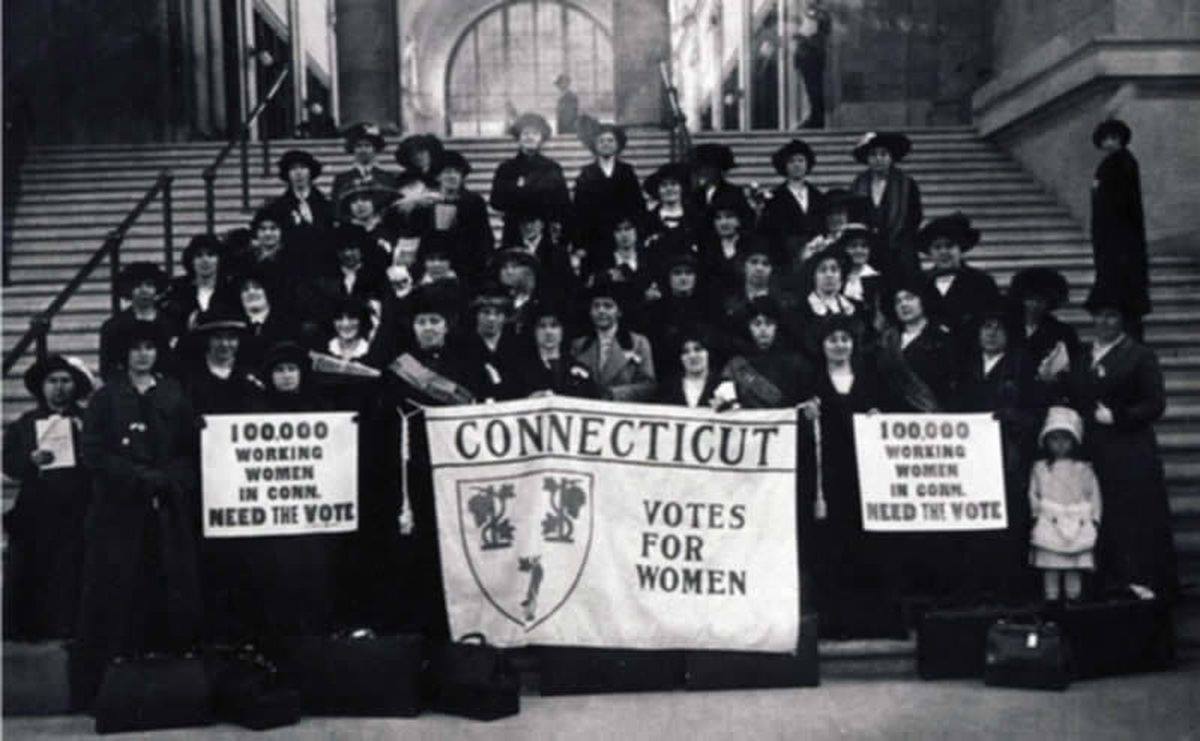
August 28, 2020
The Connecticut Women’s Suffrage Association began in 1869 and journeyed along the path that took over 50 years before Connecticut women gained the right to vote. It was not an easy path for these women and it took the official ratification by Tennessee to motivate the Connecticut legislature to ratify the 19th Amendment in September 1920.
It must be acknowledged that the women’s suffrage movement failed women of color. It took many more years before Black, Latina or Native American women could vote. In Connecticut, finally there is recognition of these Black women who fought for the right to vote, like Hartford's Mary Townsend Seymour, the first Black woman in the United States to run for state office, New Haven resident, Minnie L. Bradley, and from Old Saybrook, Anna Louise James. For more information on Connecticut women of color and the fight for suffrage, go to: https://chs.org/wocvotes/
For decades, Connecticut suffragists had picketed, petitioned, and frequently found themselves arrested on behalf of their passionate efforts to expand American voting rights to female citizens, only to have their efforts stymied at every turn by entrenched state politicians who feared what the sudden influx of over 200,000 new women voters would do to their incumbencies. In Connecticut and Vermont, conservative Republican governors refused to call their legislatures into session.
After ratification, the state of Connecticut called a special legislative session to “provide the state with sufficient legal basis for receiving women as voters,” including increasing the number of registrars. Connecticut and other states also automatically rolled women registered for school elections (permitted by a number of states prior to 1920) over to general election lists.
Even the General Assembly’s vote of September 14, 1920 was little more than a symbolic and politically expedient move: three weeks before, Tennessee became the 36th state to ratify the 19th Amendment, ensuring its implementation at the federal level and rendering any subsequent state votes — like Connecticut’s — moot.
Still, the CWSA’s efforts were essential to and recognized by the national movement. In Elizabeth Cady Stanton’s History of Woman Suffrage (Volume V: 1900-1920), we learn that “Connecticut women made a magnificent campaign” for adoption of the Federal amendment when it first came before the State legislature, where it failed by only one vote in the Senate after passing in the Congress. “The strength displayed by the suffragists, the obtaining of 98,000 women’s signatures and the dignity and ability shown under the leadership of Miss Katherine [sic] Ludington, so advanced suffrage in that State as to make the battle seem a victory rather than a defeat.” Though woman suffrage efforts in Connecticut may have been defeated in their wish to be that deciding 36th state ratification, they won the day by not relenting until that successful September 14 vote.
The League of Women Voters of Connecticut was formed as an offspring of the Connecticut Woman Suffrage Association (CWSA) which came to an end with ratification of the 19th amendment to the United States Constitution. The League was founded at New Haven, Connecticut on January 18, 1921. The non-partisan League was organized to educate newly enfranchised women voters and in turn use the voting power of members to press for legislative reforms. An early issue for the League was advocating for the rights of women to serve on a jury in Connecticut.
As women began to exercise their right to vote, the state election laws contained a range of restrictions and requirements at the time of women’s enfranchisement, and permitted considerable bureaucratic discretion in the enforcement of those laws. Black women in the South were particular targets. Even states that accommodated women often had restrictive election laws that created barriers for women. Despite extending registration opportunities for women, both Connecticut and Massachusetts required a literacy test. Massachusetts added a poll tax, while Connecticut piled on a morals clause and a long residency requirement.
In Bridgeport, Connecticut, for example, the “veteran registrar of voters” claimed women’s suffrage required “a great deal of extra work, but can be done nevertheless.” In anticipation, Bridgeport ordered fourteen new voting machines, enough to handle a doubling of the electorate, although the registrar doubted “it will go that high.”
Though Connecticut took some steps to accommodate women voters during registration, turnout hovered just above 20 percent—likely a reflection of the states’ exclusionary voting restrictions, including literacy tests and poll taxes. States with more voting restrictions (especially Virginia, Massachusetts, and Connecticut) had considerably lower turnout overall, but especially among women.
As we look back and reflect on the women's suffrage fight, we must always look forward and ensure that all citizens can vote without impediment. There is still much to do to empower voters and defend democracy.
-----------------------------------------------
Compiled by Carol Reimers, President of the League of Women Voters of Connecticut from 2019-2021
Resources: Connecticut State Library, Professor Brittney Yancy and Connecticut Historical Society, Smithsonian Magazine, Connecticut History.org, a Connecticut Humanities project, https://votesforwomenct.com and J. Kevin Corder and Christina Wolbrecht, authors of Counting Women’s Ballots.